Marco Rose wasn’t the only manager to make the switch to the German Bundesliga from its Austrian equivalent last summer. Oliver Glasner made his way across the border with considerably less fanfare than Rose to join Wolfsburg as their Head Coach, and immediately there were obvious improvements for everyone to see. This was particularly so in the case of Wolfsburg’s defence, conceding just five goals in their first nine league games. Even up to this point they have only conceded more than one goal in four league games.
Despite sitting in ninth-place at the halfway point, Wolfsburg have the meanest defence in the league, along with Rose’s Borussia Mönchengladbach, having conceded just 18 goals. This tactical analysis and scout report looks at the tactics Glasner has used to create such an effective defence.
Their tactics at a glance
Glasner prefers to play a 3-4-3 formation, as he did so successfully in his tenure at LASK Linz. In doing so, his two wing-backs, William and Jérôme Roussillon give width in midfield to allow the front three to play closer to one another. As they defend the formation drops into a 5-4-1 with William and Roussillon making a defensive back five with the central defensive three, whilst the two wide forwards drop into midfield to create a midfield four once again.
A criticism of Glasner has been his lack of flexibility in formations, however, in the last three games of the Hinrunde he fielded a back four, with a 4-1-4-1 in two games, as Wolfsburg beat Mönchengladbach 2-1, and drew 1-1 with Schalke, both good results but particularly in the case of the former, and we may well see this more frequently in the second half of the season. He fielded a 4-3-3 in the 2-0 loss to Bayern Munich.
There are aspects of their defence which are consistent throughout, and although hardly groundbreaking, are done with such discipline and rigour, that they very much provide the backbone to Wolfsburg’s defence.
Firstly with the opposition inside their half, they will drop plenty of players back into a deep block, and although there is a slight variation in the depth of this block, there will always be one, if not two, central midfielders acting as a screen in front of the backline.
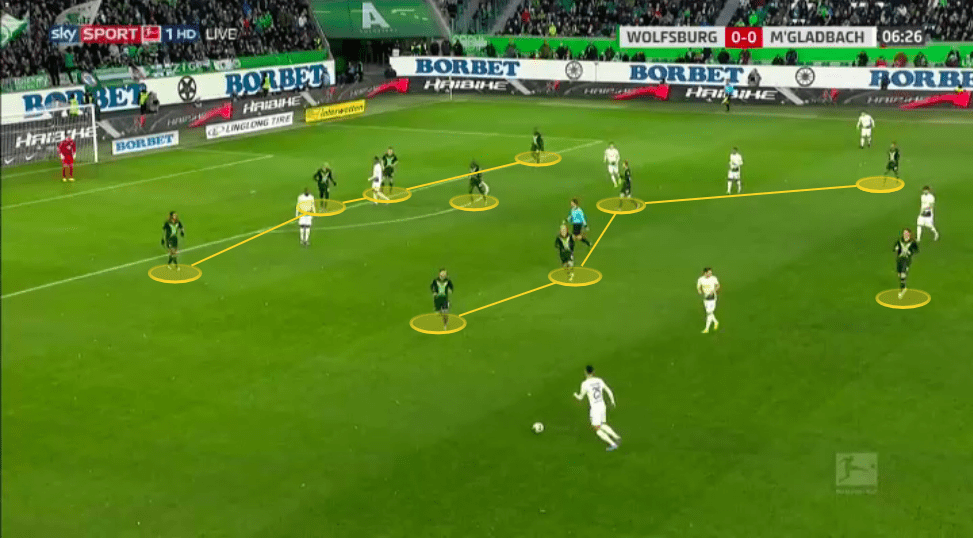
Secondly, they play with a great compactness most noticeably in regards to their width, whether they are playing a back four or a back three.
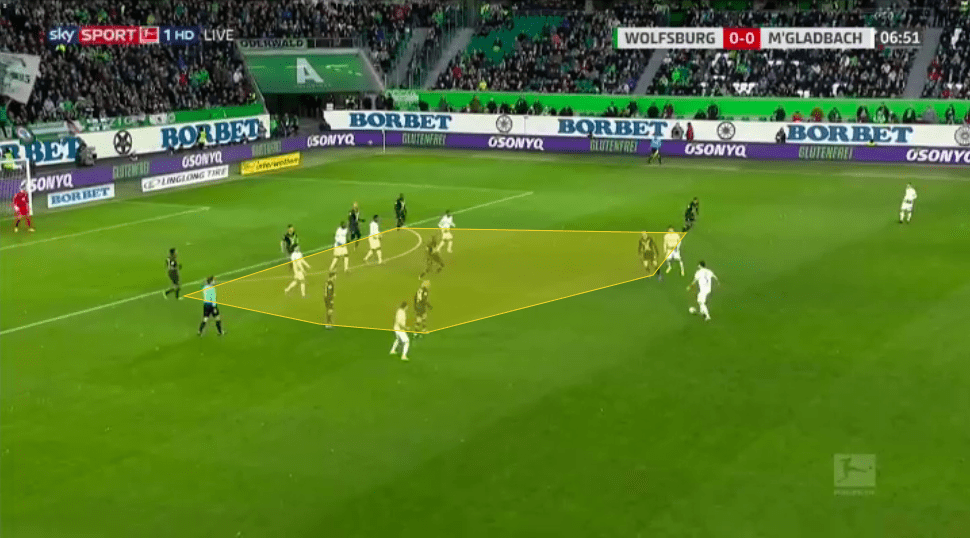
The last (near) constant out of possession is their press. Now, this naturally varies in intensity, and with triggers, depending on the strength of the opposition. However, generally, they operate with a high press, and there have only been three league games this year where they have registered a PPDA higher than 12.
The high press
When playing as a 3-4-3, as they typically do, the front three will engage in a high press with lateral and backwards passes acting as a trigger to increase the intensity.
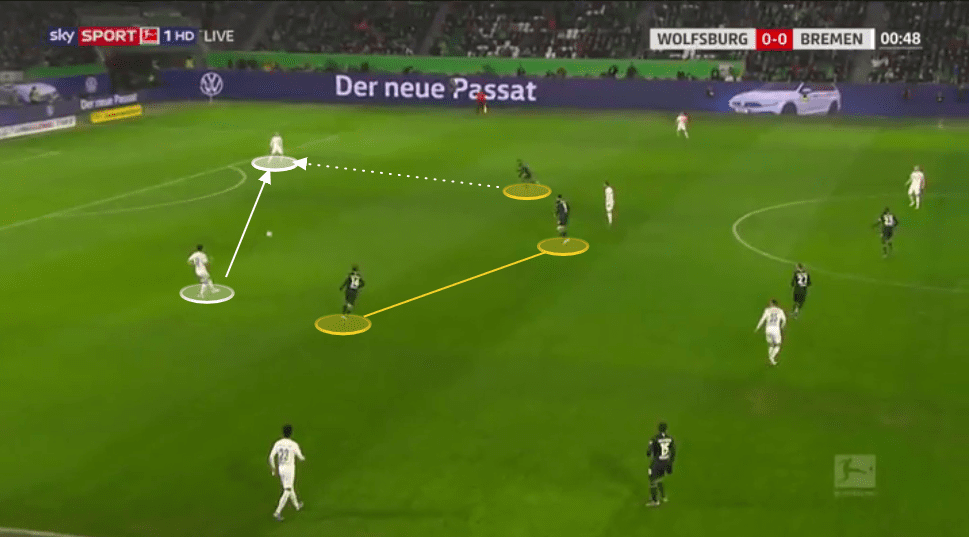
The two wide forwards of the front three will sit deeper in order to continue the press should the opposition break the first line, whilst preventing the centre-backs from playing to the full-backs, or as in the analysis below, the goalkeeper from playing to his two centre-backs.
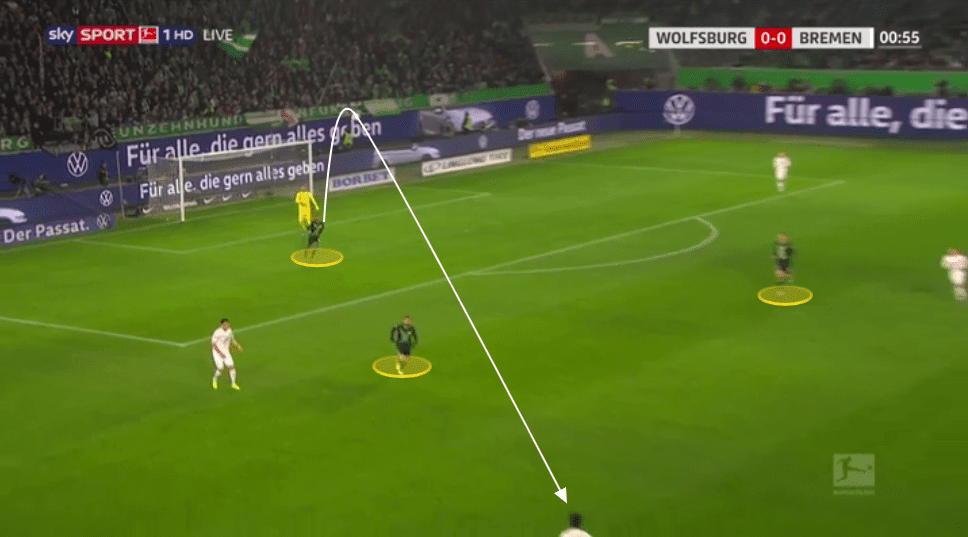
The knock-on effect of this is it forces the opposition to play long.
As we can see in the image below, both of the wide forwards are able to quickly drop back and help swarm the opponent who has received the less than ideal lofted pass from his goalkeeper. They join left wing-back Roussillon and central-midfielder Maximilian Arnold in pressuring the recipient.
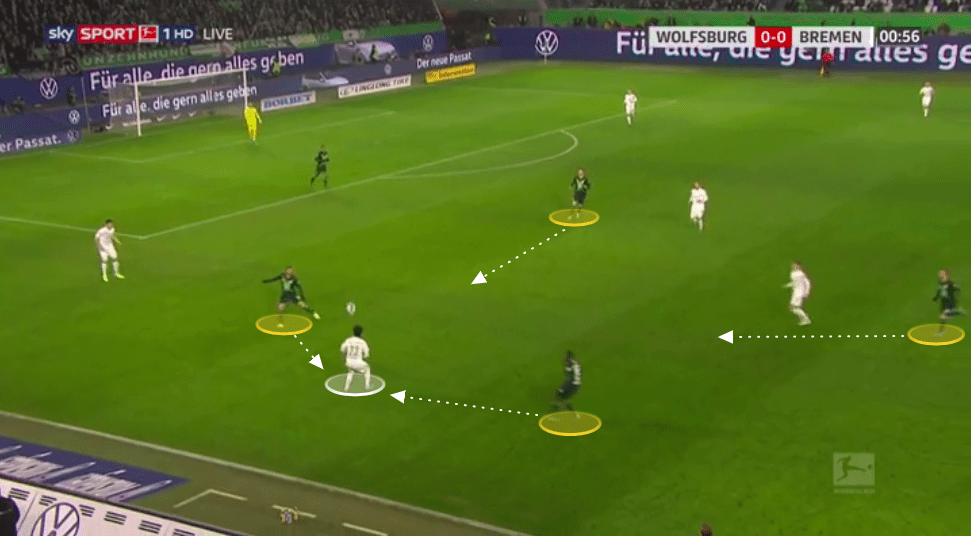
These are the basics of their system when playing with a three, however, as mentioned earlier they have recently used a back four more frequently, and the press does change slightly in this case.
The image below demonstrates this press-set up, as Wout Weghorst still leads the line and presses the back two, whilst the rest of the side are more interested in blocking passing lanes, with the wingers preventing the easy pass to the full-backs. In this scenario, Xaver Schlager is often the man to push forward and help Weghorst in the initial press, as they seek to force the opponent to play long once more, whilst maintaining a little more depth in midfield, particularly in central areas.
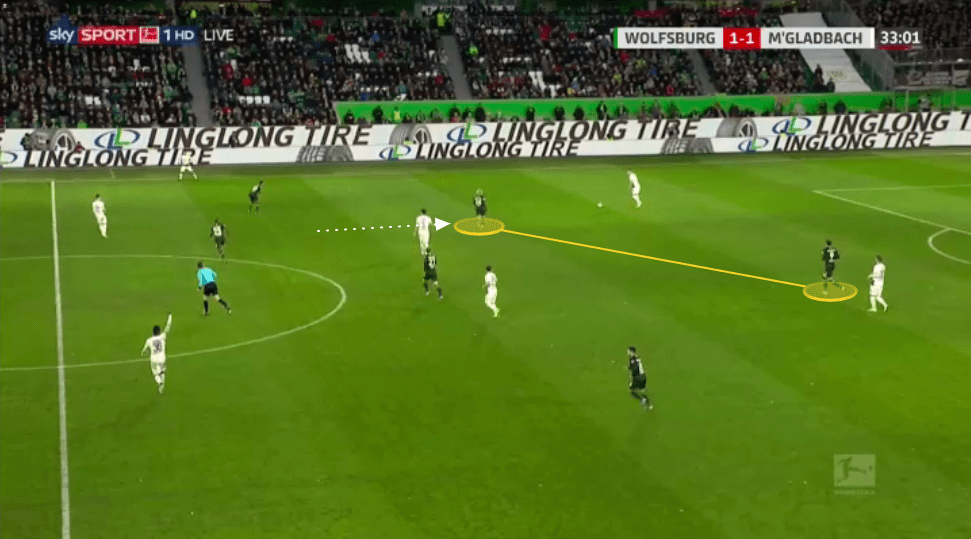
How the midfield contributes to their defensive shape
As mentioned above, when playing with a back three, they have support from their wing-backs when the opposition are in an advanced area, with both William and Rousillon dropping deep to create a back five. If the ball is played down the flank one of the wing-back’s pushes forward, leaving a back four as Wolfsburg shift across. Wolfsburg’s two wide forwards will also drop deeper to create a midfield four, leaving Weghorst by himself as a lone forward.
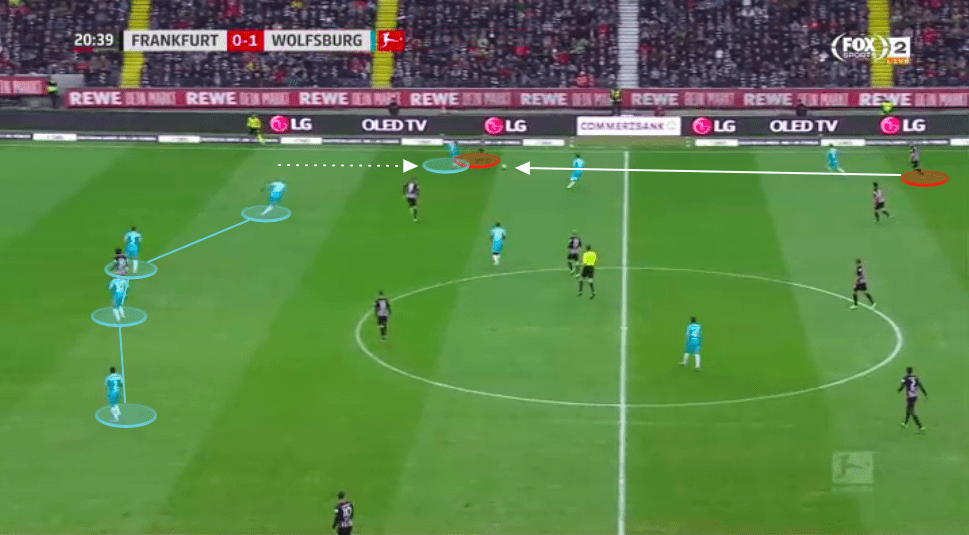
It is Glasner’s priority to ensure there is a back five so they are able to defend a threat in wide positions, whilst ensuring there is a compact back four protecting the central areas.
This isn’t always possible though, and if they lose the ball in transition, or individuals are pulled out of position, it can leave them vulnerable should this shape fall apart.
You will see Wolfsburg striving to keep this defensive shape even when playing as a back four they will still sometimes utilise a back five. Josuha Guilavogui will drop into support the central defenders as the analysis below shows.
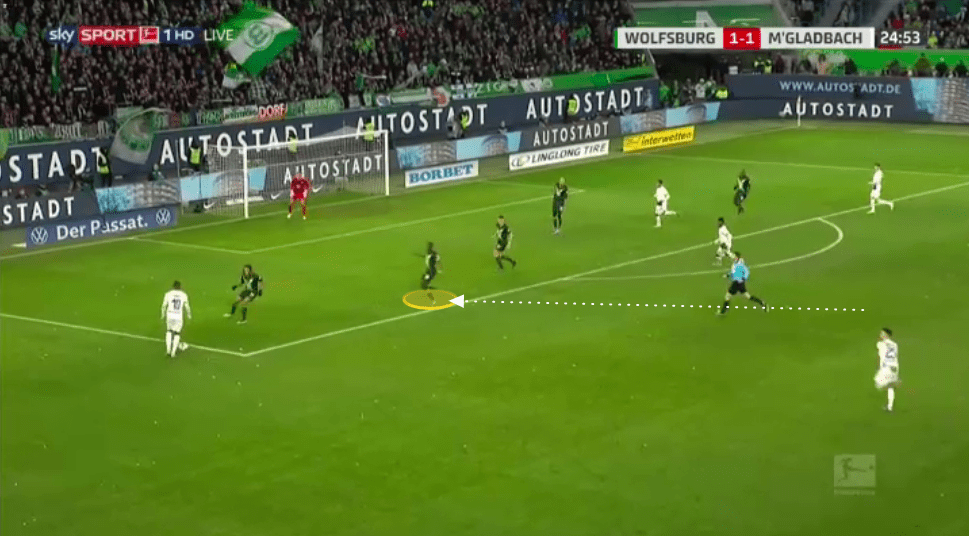
The midfield are excellent at providing support and balance to the backline and have gotten better at supporting the defensive transition since their issues earlier in the season. The image below shows William losing possession in a wide area and, now out of position, Marcel Tisserand has to cover. Due to their deep positioning themselves, one of Wolfsburg’s central midfield pairing, most often Guilavogui and Arnold, can, therefore, drop in and ensure Wolfsburg have that back five, even when facing a counter. This is an issue they have had this season and I will delve into this in more detail later.
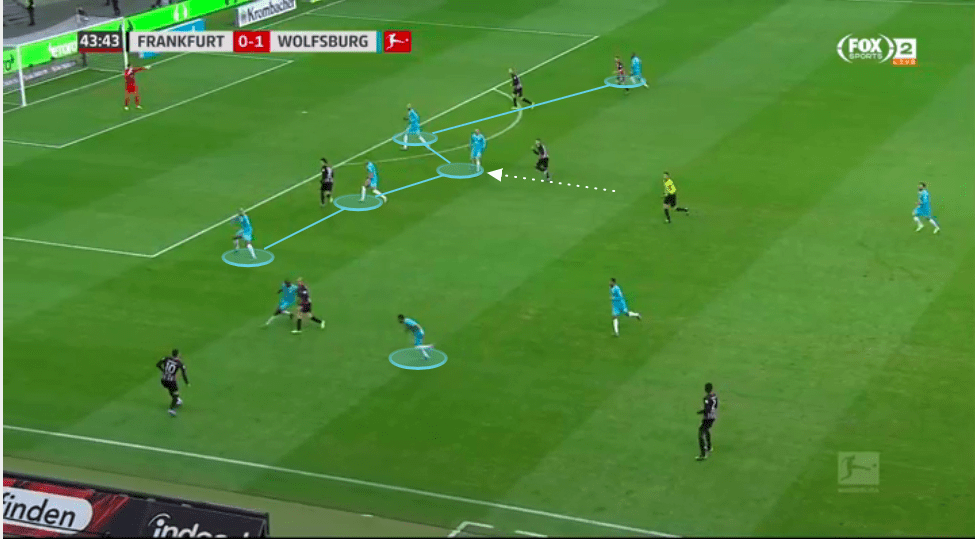
Wolfsburg’s midfield look to screen the back four and their deep positioning makes it difficult for the opposition to get good shooting positions from central areas, and force them wide to take their shots.
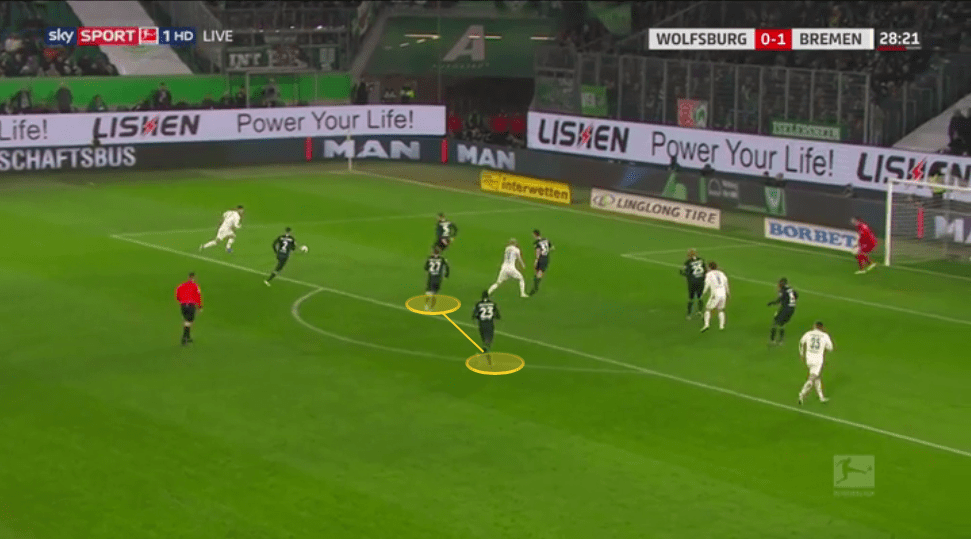
Areas for improvement
Despite their impressive record this season, there are unquestionably weaknesses in this Wolfsburg defence that have been exploited on occasion this year.
Firstly, their compactness can lead to too much space on the flanks, and they are particularly at risk from counter-attacks in these areas.
Wolfsburg have been found out this season with deep crosses from counter-attacks. As Wolfsburg push forward, both William and Rousillon push into orthodox wing positions, to provide Wolfsburg with their width in attack and allow their front three to play close to one another. However, should they lose possession, the opposition will look to isolate the back three, and they have conceded on several occasions this season through exactly this, with an overhit cross to the opposite flank, towards the awaiting opposition wide forward pushing forward in support on the counter.
Werder Bremen’s second goal from their 3-2 victory of Wolfsburg is an example of how to get around their system and attack whilst they don’t have five back. As William lost possession they displayed quick counter-attacking with a deep cross behind the third centre-back, after winning in a high and wide area.
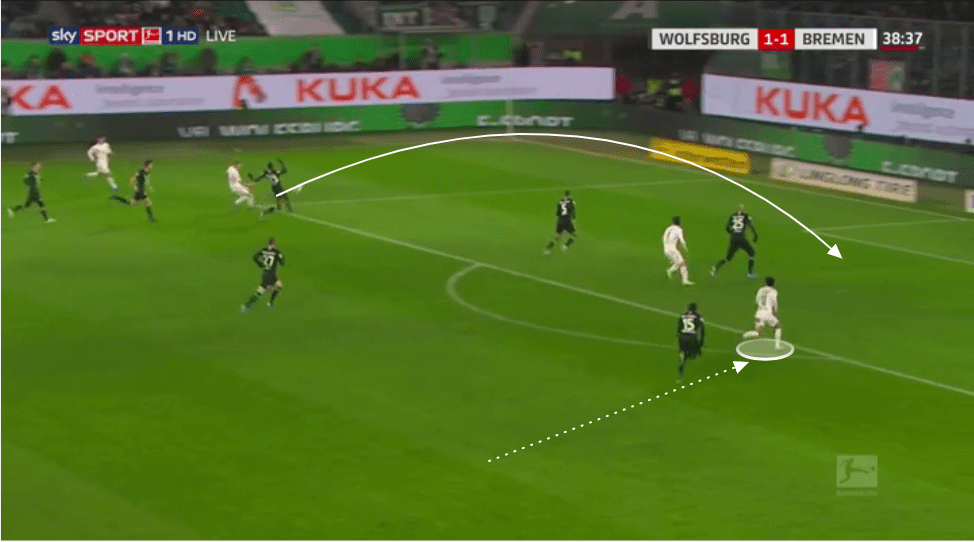
There are also spaces to be found between the centre-backs and Borussia Dortmund in particular exploited this in their meeting earlier this season.
Dortmund focused on attacking the individuals of Wolfsburg’s back three and drawing them out of defence by having their quick attacking players run directly at them with the ball.
By running at the centre-back and having him press the ball-carrier, the centre-backs either side of him would naturally tuck around behind him. This left space either side for players to support the Dortmund forward.
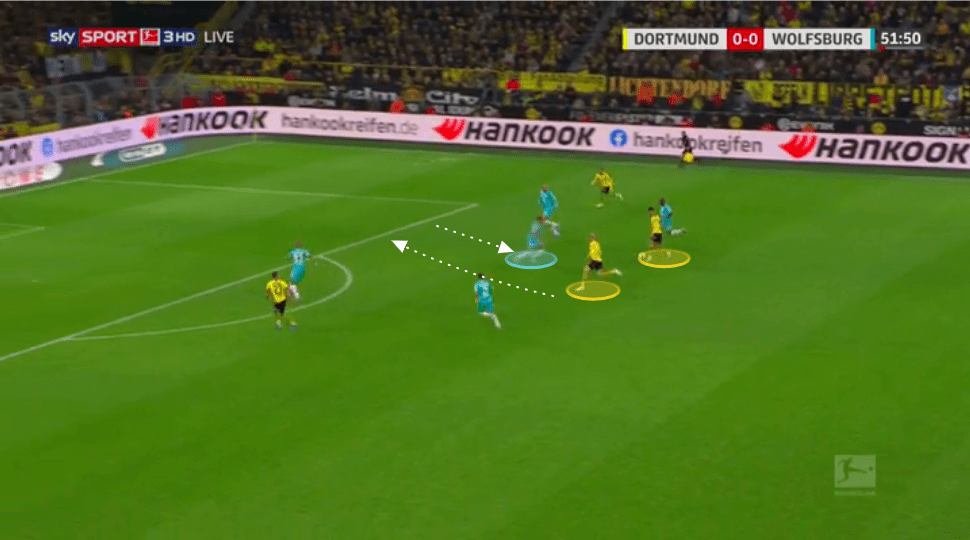
As this caused unrest in the backline, there were times where the supporting centre-backs weren’t sure of how narrow to get should one of the three get pulled forward, which also left space directly behind the pressing centre-back.
Dealing with overlapping is definitely a weakness of this system, again particularly when they face a quick break. The combination of the narrow shape and the opposition attempting to engage to pull the back three, or even back five should their wing-backs be in position, creates space on the flanks for the opposition to use overlapping to get behind the defence. The image below shows that this is particularly effective if Wolfsburg are caught too narrow, and the forward can bring one of the wing-backs forward.
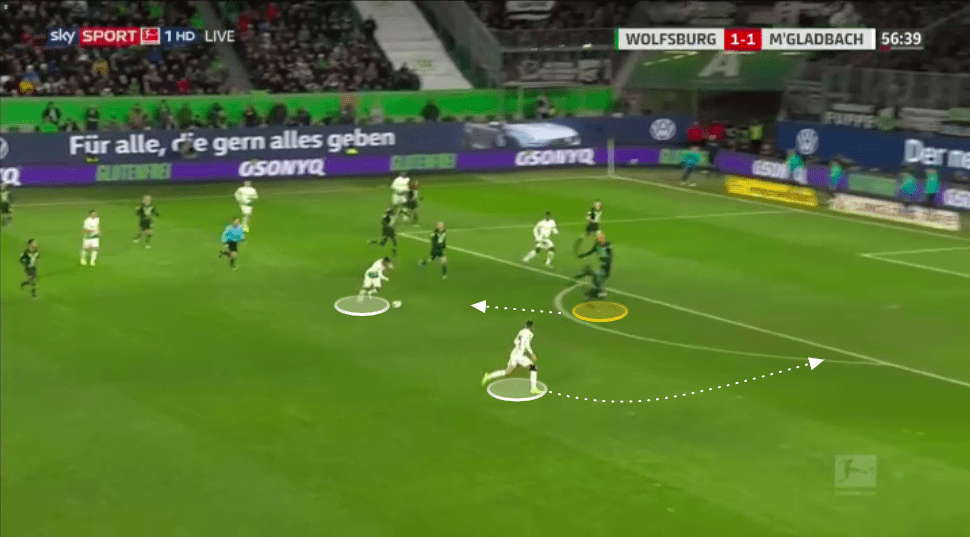
Similarly, space can be found between the defenders from deeper areas. Eintracht Frankfurt looked to find this in their meeting earlier this season. With the ball being played out from the back they dropped an extra central-midfielder into the build-up play, and in doing so were able to pull Arnold forwards out of the midfield. The knock-on effect is that Tisserand comes forward out of the back three to pick up Gonçalo Paciência who drops deep himself. This gives space for Mijat Gaćinović to move into the space created between William and Jeffrey Bruma and look to receive the long pass.
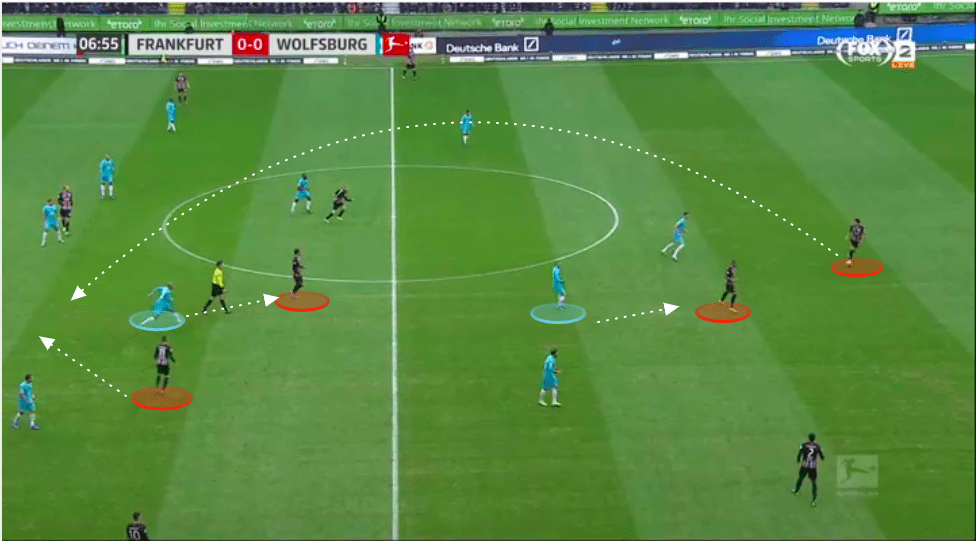
Even more simple is the movement from the forward into the space between midfield and defence to show for the ball with the centre-back in possession, and move back into the space created by this run, again looking for the direct ball over the top, as we can see below.
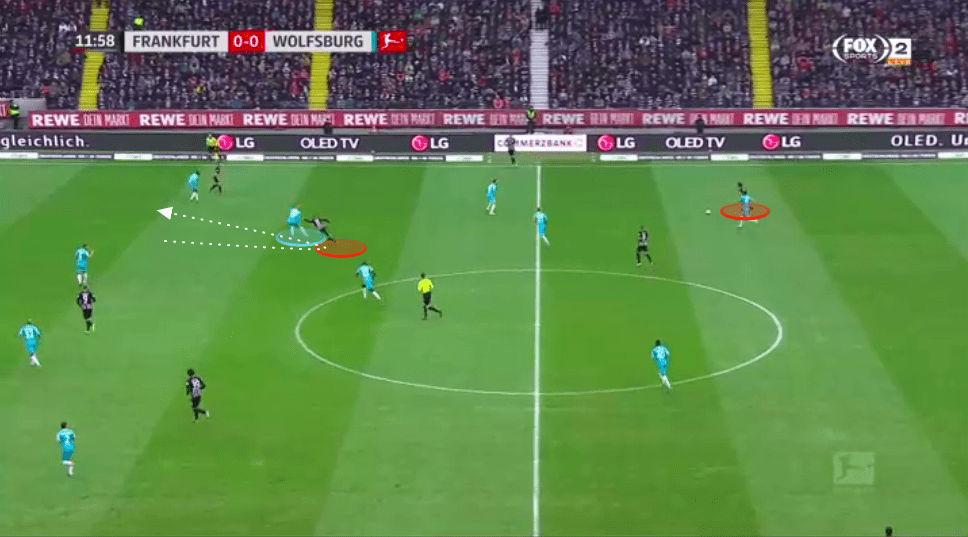
Conclusion
Despite an aggressive press, which is certainly useful in helping Wolfsburg regain possession in higher areas, there is no doubt that their defence is so difficult to break down due to how little space they provide in central areas, both across their back five or in midfield. Their commitment to ensuring they have numbers back at all times and the role their wing-backs and central-midfielders play in enforcing this is vital.
However, there are nevertheless still areas for them to work on and make this defence even stronger.
They need to improve at dealing with counter-attacks, and not allow teams to exploit their compactness from wide areas.
Yet it is likely their commitment to such a robust defensive system that is partly down to their shyness in front of goal this campaign, scoring just 18 goals leaving them with a goal difference of zero. As well as having the joint-best defence in the league, they have the joint-worst attack too, level with Fortuna Düsseldorf.





Comments